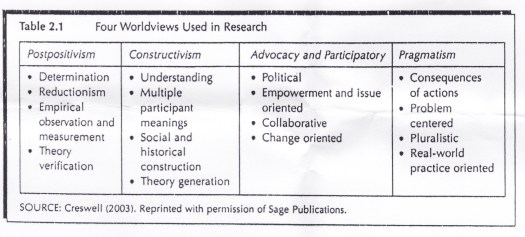Research design simply refers to the plan for carrying out the research. Quantitative research designs can be classified into two main designs: experimental designs and non-experimental designs.
EXPERIMENTAL DESIGNS
Experimental designs refer to the plan of research that involves a treatment. Experimental designs can further classified as pre-experimental, true experimental, or quasi-experimental. They are distinguished based on the degree of control applied by the researcher and whether randomization is done or not. Degree of control refers to the degree of the researcher control over other variables that are not investigated but may influence the result of experiment. Randomization refers to the random procedure in assigning subjects into the control and experimental groups. See the table below:
| Design |
Control of other variables |
Randomization |
| Pre-experimental |
NO |
NO |
| True experimental |
YES |
YES |
| Quasi-experimental |
YES |
NO |
If the control over other influential (extraneous) variable is not done and randomization is not done, the design is called pre-experimental. If the control over extraneous variables and randomization are done, it is true-experimental. If the control over the extraneous variables is done, but randomization is NOT done, it is called quasi-experimental.
Research design should have internal validity and external validity. A research design has an internal validity if with the design the treatment can bring about changes in the dependent variable. Some phenomena that threat the internal validity are: selection, history, maturation, pre-testing, instrumentation, regression, and the interaction effect among these factors. External validity refers to the generalizability of the result to the other groups/settings, population or operational definitions.
To discuss about experimental designs, we need to use some terms and symbols.
X = independent variable or the treatment.
E = experimental group (group that receives the treatment)
C = control group (group that DOES NOT receive the treatment)
S = subjects
R = randomization/random assignment
Mr = matching of subjects
Pre-experimental Designs
The pre-experimental designs can be classified as one-group pretest-posttest design and static group comparison. They can be illustrated as follows.
One-group pretest-posttest design is illustrated below:
Static group comparison design is illustrated below:
True-experimental Designs
The true-experimental designs can be classified as randomized subjects posttest-only control group design, randomized matched subjects posttest-only control group design, randomized subjects pretest-posttest control group design, Solomon three-group design, Solomon four-group design, and simple factorial designs.
They can be illustrated as follows.
Randomized subjects, posttest-only control group design is illustrated as follows:
Randomized matched subjects, posttest-only control group design is illustrated as follows:
Randomized subjects, prestest-posttest control group design is illustrated as follows:
| (R) |
E |
Y1 |
X |
Y2 |
| (R) |
C |
Y1 |
▬ |
Y2 |
Solomon three-group design is illustrated as follows:
| (R) |
E |
Y1 |
X |
Y2 |
| (R) |
C1 |
Y1 |
▬ |
Y2 |
| (R) |
C2 |
▬ |
X |
Y2 |
Solomon four-group design is illustrated as follows:
| (R) |
E |
Y1 |
X |
Y2 |
| (R) |
C1 |
Y1 |
▬ |
Y2 |
| (R) |
C2 |
▬ |
X |
Y2 |
| (R) |
C3 |
▬ |
▬ |
Y2 |
Simple factorial design is illustrated as follows:
| Level |
X1 |
X2 |
| Level 1 |
Group 1 |
Group 3 |
| Level 2 |
Group 2 |
Group 4 |
Quasi-experimental designs
The Quasi-experimental designs can be classified as non-randomized control group pretest-posttest design, counter balanced design, one group time series, and control group time series designs. See the illustration below.
Non-randomized control group, pretest-posttest design is illustrated as follows:
Counter balanced design is illustrated as follows:
|
X1 |
X2 |
X3 |
X4 |
| 1 |
Group A |
B |
C |
D |
| 2 |
Group C |
A |
D |
B |
| 3 |
Group B |
D |
A |
C |
| 4 |
Group D |
C |
B |
A |
One-group time series design is illustrated as follows:
| Y1 |
Y2 |
Y3 |
Y4 |
X |
Y5 |
Y6 |
Y7 |
Y8 |
From the illustration, it is known that measurement is done periodically (four times) before and (four times) after the treatment. The result of the periodic measurements (8 times) may be similar to either one of these patterns.

Figure 1. Illustration of possible Outcome Patterns in a Time Design
Pattern A shows that the treatment X has an effect. Pattern B shows temporary effect of the treatment. Pattern C shows no effect and pattern D shows no effect of the treatment and the strong influence of extraneous variables.
Weakness: effect of history
Control group time series design is illustrated below:
| E |
Y1 |
Y2 |
Y3 |
Y4 |
X |
Y5 |
Y6 |
Y7 |
Y8 |
| C |
Y1 |
Y2 |
Y3 |
Y4 |
▬ |
Y5 |
Y6 |
Y7 |
Y8 |
The elaboration is given in the class discussion.
NON EXPERIMENTAL DESIGNS
Non experimental designs can be classified into: ex post facto, correlational and survey designs.
Ex post facto research designs
Ex post facto research design or also called causal-comparative research design can be used to test hypothesis concerning the relationship between two variables. Basically, this is similar to experimental research. The difference is that treatment is not applied because the phenomenon observed has occurred in the past and it is not possible to apply treatment to the subject due to ethical reasons or other reasons. This design can also be used to simply see the relationship between two variables.
An important thing to do is to make sure that the variable that happens before the other variable is the independent variable.
The designs:
Design 1:
| Independent variable |
|
Dependent variable |
| Subjects are already known to be different on the INDEPENDENT variable(s) |
–> |
Test hypothesis concerning the possible DEPENDENT variable |
In this design, the researcher tries to see the consequence of the difference of independent variable on the dependent variable. He starts by identifying the differences in the independent variable, then collect the related data on the dependent variable and text the hypothesis.
Example:
You know that some of your students got English lessons in elementary school (in grade 4 to 6) and others did not.
So, you can identify this is the independent variable (previous English lesson experience). Now you can collect the data on the development of their English score from grade 7 to grade 9 as the dependent variable (English achievement development).
Design 2:
| Dependent variable |
|
Independent variable |
| Subjects are already known to be different on the DEPENDENT variable(s) |
–> |
Test hypothesis concerning the possible INDEPENDENT variable |
In design two, the researcher starts with the fact that the subjects have differences concerning dependent variable. Then, he collects data on the possible causes of the difference (independent variable). Finally he tests the hypothesis.
Example:
You know that your students have different ability in pronunciation. Measure them as the dependent variable. Then, look for the possible cause, for example, Arabic learning experience as the independent variable (previous experience in learning a foreign language). And you can relate the two variables.
Correlational Research Design (with two variables)
The design is very simple. However, please be careful. Correlational research design can be used to prove the existence of causal relationship.
| Variable 1 |
Variable 2 |
Testing hypothesis |
| Collect data on Variable 1 |
Collect data on Variable 2 |
Test hypothesis |
Survey research design
Survey is a research technique of gathering data by asking questions to a group of individual (respondents).
Types of survey
Based on the focus and scope, survey can be identified as either census or sample survey. Census covers the whole population of interest. A sample survey only study a portion (sample) of this population of interest.
Based on the time dimension, surveys can be classified as longitudinal survey and cross-sectional survey. A longitudinal survey is done several times at different points of time on the same group of respondents. The time of measurement can be every year or every two years, or other interval to see the changes over time. This type can be divided into two: panel survey, trend study, cohort study. In panel survey, the same subjects are measured over time. In trend study, the measurement are not done on the same subjects over time, but on the sample taken randomly from the same group in different time. The members of the group may be different. Because the sample was taken randomly, they are considered equal. For example, survey of the SMU LAB students on smoking and friendship is done every two years, with different sample because the previous students must have graduated.
In cohort studies, the sample is taken from a group with the same membership. For example, a survey is done on the topic of the value of independent work. The subjects are the person experiencing modular learning experience. The data are collected when the students where in grade 2, then two years after that, and every two other years up to five times of data collection. The real sample can be different, but they must be graduate of the same school.
Cross-sectional survey
This study asks questions to cross-section sample of the population at a single point in time. For example, the research can ask Grade 7, Grade 8, and Grade 9 students about their opinion of the importance of English at the same time rather than asking student of Grade 7 this year and ask them again next year and next two year (longitudinal).
Data-gathering techniques include: personal interview, telephone interview, mailed question, direct questionnaire, and internet questionnaire.
Assignment: Decide the design for your research idea. Of course, there is only one design that you will use for your research.
Reference: Ary, Donald, et al. 2002. Introduction to Research in Education. Belmont: Wadswroth Group



